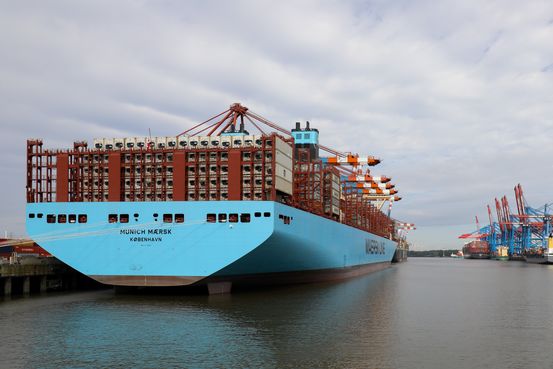
A great shipping giant
A.P. Moller Maersk
A/S is making rapid efforts to switch to carbon neutral ships. In two years’ time, the first container ship will be sailing on biofuels.
Newsletter subscription
Report on logistics
The best news and in-depth analysis from the world of logistics, from supply chains to transportation and technology.
Denmark’s Maersk Line is the largest container line in the world, according to maritime data provider Alfaliner. This change could accelerate efforts by energy suppliers to develop significant amounts of non-fossil fuels suitable for powering ocean-going vessels.
The Maersk will be a small ship, called a feeder, which can carry up to 2,000 boxes. It will join the network in 2023, seven years earlier than announced, the company said Wednesday. The ship will also be able to burn conventional bunker fuel, and Mr Maersk said this dual propulsion system will be present in all future ship orders.
Maersk is working with ship engine manufacturers to develop a dual engine system. The possibility of using different types of propulsion is already available for many new ships launched by other companies, in particular new ships which can operate both on conventional bunker fuels and on natural gas.
Maersk’s new ship will run on biomethanol, which can be produced from waste from paper mills and other by-products or by mixing hydrogen with carbon dioxide captured in industrial exhaust systems.
We haven’t decided which way to go yet. It will depend on where we can get the fuel, explains Morten Bo Christiansen, who is responsible for decarbonisation at Maersk.
Maersk chose biomethanol because it is available now, but the company is also exploring other fuels, such as. B. Ammonia, for the future.
Several major shipping companies have experimented with biofuels.
Ocean Network Express Pte, a Singapore-based express network owned by the Japanese company Ocean Network Express Pte. Ltd. sent a tanker across the Atlantic earlier this month with a mixture of cooking oil and bank fuel. Norwegian operators use small ferries and battery-powered freighters for short trips.
According to the International Maritime Organization, the United Nations maritime regulatory body, ocean-going vessels are responsible for approximately 2.5% of global greenhouse gas emissions. This amount is comparable to the emissions of some of the largest countries in the European Union.
IMO member states have agreed on a plan to improve the fuel efficiency of some 60 000 ocean-going vessels by 40% over the next ten years and halve the total greenhouse gas emissions from ships by 2050 compared to 2008 levels. Some of the world’s largest ship financiers have agreed to provide loans for ships built with lower emission levels.
Maersk says it aims to have a fully carbon-neutral fleet by 2050.
One of the biggest challenges for shipping companies is finding enough fuel to power today’s ultra-large cargo ships, which carry more than 20,000 containers over thousands of miles.
We are working on large engines that can move large ships. We are going to expand our fleet in the future and we need technical solutions for large vessels, Christiansen says.
Write to Costas Paris at [email protected].
Copyright ©2020 Dow Jones & Company, Inc. All rights reserved. 87990cbe856818d5eddac44c7b1cdeb8





